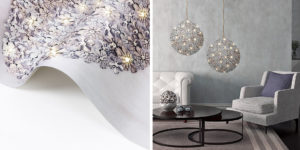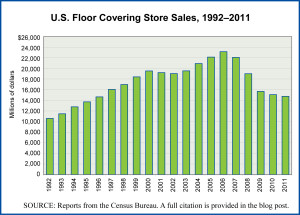
Year: 2020 and 2025
Market size: $2.9 billion and $7.5 billion, respectively
A new year. A fresh start. As many of us spend more time at home during the pandemic, some of us may be thinking about updating our décor. Perhaps a new couch to replace our old worn one. New artwork to personalize our home office. Or perhaps the walls in our home need a pop of color with a new coat of paint or new wallpaper? Today’s market size shows the estimated global revenues for digitally printed wallpaper in 2020 and projected revenues for 2025. Digitally printed wallpaper is a small slice of the overall $6.9 billion global wallpaper market.1
The majority of wallpapers sold are screen printed or printed using ink and rollers. They generally have repeating patterns and offer a limited number of colors and designs. In order to be profitable, large numbers of rolls have to be produced and sold by the manufacturer. In general, 30 to 50 different designs comprise a collection, with manufacturers producing and warehousing 30,000 to 100,000 rolls, not knowing which designs will sell well and which others will remain in the warehouse unsold. Because designs change periodically, consumers who may need to repair a section of their wallpaper in the future may find that the matching pattern has been discontinued.
Digitally printed wallpaper, on the other hand, can be custom-made to the preference of the consumer. Printed either using specialized, wide-format inkjet printers or electrophotography,2 the number of patterns and colors are endless, only limited by the design software, printer, and ink used. Because the wallpaper is created on-demand, there’s no need for manufacturers or interior design firms to store multiple rolls of wallpaper. Obtaining replacement sections when the wallpaper needs repair is easier also as the section needed can be printed from a digital file the manufacturer has on hand. Digitally printed wallpaper can have traditionally repeated patterns or large-scale patterns. It can also be high-definition photographic murals. Some manufacturers offer drawing-onto-wallpapers in which the entire wall can be like one big page in a coloring book. Others offer three-dimensional digitally printed wall coverings.Wallpaper comes in many varieties, including paper, coated fabric, vinyl-coated paper, paper backed vinyl/solid sheet vinyl, fabric-backed vinyl, and solid vinyl. Vinyl led the digitally printed wallpaper market in both volume and value in 2020. Its high durability, easy maintenance, and lower cost will drive the growing demand for this type of wallpaper at least through 2025. Vinyl wallpaper is best suited for humid or high-traffic areas such as bathrooms, kitchens, and hallways.
Lack of raw materials and a reduced workforce due to COVID19 safety protocols hampered the digitally printed wallpaper supply chain in 2020. Also, the industry was impacted by the lockdowns in many countries as production facilities shut down. As a result, it’s estimated that revenue declined through the third quarter of 2020. In addition, the slowdown in the construction of both residential and non-residential buildings hampered growth in this industry.
As life slowly gets back to normal in the coming years, industry revenues are expected to grow at a compound annual growth rate of 21.1% through 2025, with the residential segment leading the way, especially in the Asia-Pacific region. The major factor driving growth in this region is the ongoing and upcoming large-scale government investments in infrastructure in China, Japan, and India. Most major global manufacturers are based in Germany, the United Kingdom, and the United States. Those companies include A.S. Création Tapeten AG, Muraspec Group, Tapetenfabrik Gebr. Rasch GmbH & Co. KG, MX Display, 4Walls, Flavor Paper, The Printed Wallpaper Company, Hollywood Monster, and Great Wall Custom Coverings among others.
1 Figure for the overall global wallpaper market is for 2018.2 In 2018, in the United States electrophotographic technology accounted for about 5-10% of digitally printed wallpaper.
Sources: “The Global Digitally Printed Wallpaper Market Size is Estimated at USD 2.9 billion in 2020 and is Projected to Reach USD 7.5 billion by 2025, at a CAGR of 21.1% from 2020 to 2025,” GlobeNewswire, December 21, 2020 available online here; “Wallpaper Market to Reach US$ 11,286.7 Million globally by end of 2027 – Coherent Market Insights,” GlobeNewswire, May 20, 2020 available online here; Melissa Donovan, “Digitally Printed Wallpaper,” Industrial Print Magazine, February 2020 available online here; “Why Interior Designers Use Digitally Printed Wallpaper,” Parallax available online here; “Environmental Graphics,” Parallax available online here; “What Are the Benefits of Digital Wallpaper Printing?” Xiekon available online here; “Digitally Printed Wallpapers vs Conventional Wall Decor Paintings,” Six Colors Printing available online here; Nancy EV Bryk, “Wallpaper,” How Products are Made available online here; “Types of Wall Coverings,” Wall Coverings Association available online here.
Image source: Viarasp, “File:Digitally Printed LED Wallpaper with Crystals Germanium.jpg,” Wikimedia Commons, July 15, 2015 available online here. This file is licensed under the Creative Commons Attribution Share-Alike 4.0 International License.

